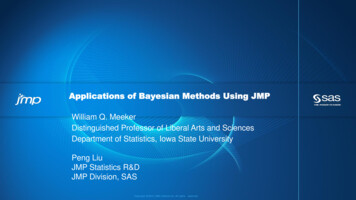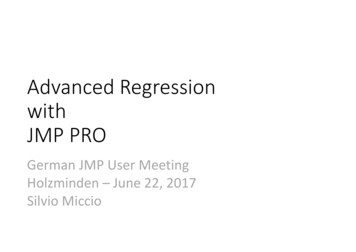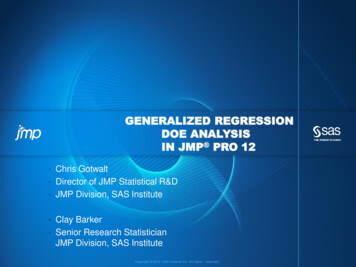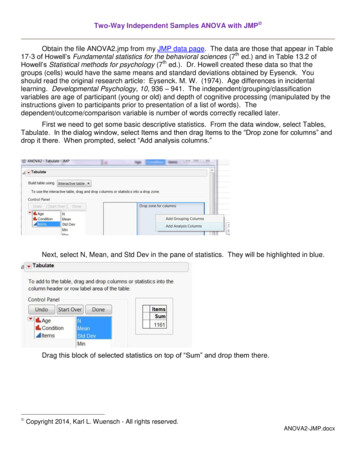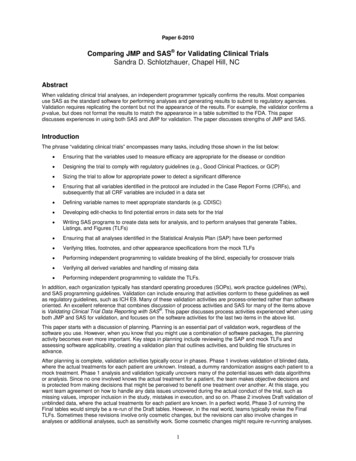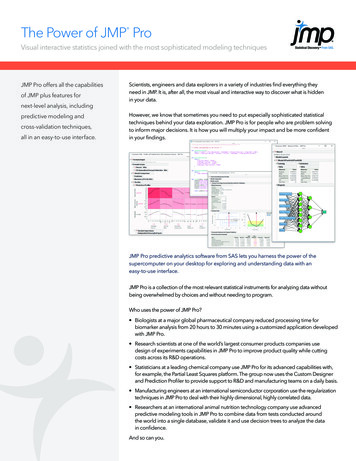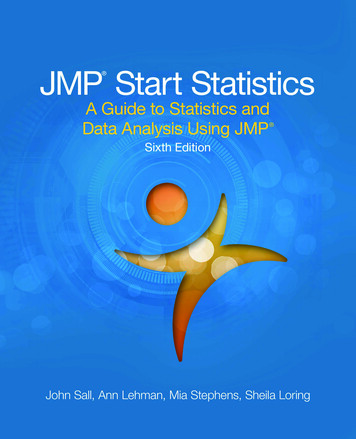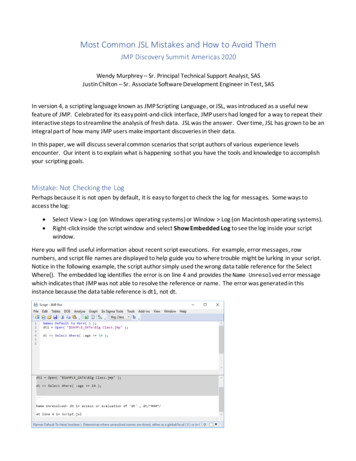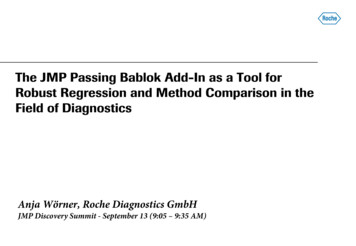
Transcription
The JMP Passing Bablok Add-In as a Tool forRobust Regression and Method Comparison in theField of DiagnosticsAnja Wörner, Roche Diagnostics GmbHJMP Discovery Summit - September 13 (9:05 – 9:35 AM)
Overview Overview– Guidelines– Linear Model– Bias at the Decision Point Correlation coefficient Regression methods Implementation in JMP
Method Comparison - Overview With the help of method comparison experiments (studies), agreement betweentwo methods of clinical measurement can be assessed Answer the question: „Are the methods comparable enough, that one might bereplaced by the other with sufficient accuracy“Have a look at:CorrelationcoefficientRegressionmethods
Method Comparison - Guidelines CLSI EP09-A2-IR: Method Comparison and Bias Estimation Using PatientSamples; Approved Guideline – Second Edition (Interim Revision) CLSI EP09-A3: Method Comparison and Bias Estimation Using Patient Samples;Draft Guideline-Third EditionItem – key differencesEP09-A2EP09-A3Level of DetailModerateHighNoneEstablishment, Validation, MethodIntroduction (Verification)40 laboratory (customer)40 laboratory (customer)100 manufacturer100 manufacturerLinear RegressionLinear Regression, DemingMethod comparison categoriesNumber of samplesQuantitative AnalysisPassing BablokBias estimation (calculation)Characterization Method comparison studiesimplementedimplementedn/aTube type, samples types
Method Comparison – SOP Design SOP RS0013 Method Comparison according to CLSI EP09-A3– Heterogeneous quantitative assays Establishment, characterization and validation 120 samples to prove a specified deviation of /- 3% 100 samples to prove a specified deviation of /- 5% or more– General Requirements Analyte conentrations of the samples have to lie within the measurmentrange, as specified in the PSD or IFU for both methods 90% of the measurement range have to be covered Both methods have to be treated in the same way (serum or plasma) To spike with analyte or to dilute the samples is allowed, if themeasurment range can‘t be covered by native samples
Method Comparison – SOP Evaluation SOP RS0013 Method Comparison according to CLSI EP09-A3– Following statistical measures have to be evaluated Correltation coefficient:r (Pearson) and tau (Kendall) Regression methods:Passing-Bablok, Deming, Linearregression (Deming and linear regressioncan be done weighted or non-weighted) Parameter:slope, intercept, bias, with 95%confidence intervals Descriptive statistics:N, mean, median, minimum, maximum CUSUM-Test:results from regression analyses can onlybe used if the CUSUM test (99% niveau)was ok. If linearity can not be shown,further risk analysis is required.
Linear Model With the help of method comparison experiments, agreement between twomethods of clinical measurement can be assessed In order to detect systematic and proportional deviations between two methods,we choose the method comparison approach, a regression line. To compare method X with method Y, systematic and proportional deviations arepossible, ie The two methods are assumed to be equivalent if a 0 and b 1
Bias at the decision pointBy the regression model, the result of the comparison methods is always given by two variables:intercept and slope. To convert this into a meaningful size of the bias is considered at one or moredecision points.The critical result of the comparison method is the difference between the two methods (bias) at thedecision point (cut-off). The calculation is done using the appropriate regression model.Bias is defined as:where a, b - the regression parameters, andYi - the calculated from the regression("estimated") values of the 2nd Presentmethod.
Bias at Decision Point
Relative BiasIn addition to the absolute bias, also a relative bias can be calculated, based on theMedical Decision Point:Depending on the test the permitted relative bias can vary. For example a relativebias of up to 10% can be allowed at the cut-off.For very small values of the MDPs values, the relative bias can be large.For large MDPs values the relative bias seeks against b-1 (slope -1).In the lower and middle range the intercept is considered in the calculation ofthe bias.
Correlation CoefficientPearsons rKendalls tauSpearmans rho
Correlation CoefficientPearsons rKendalls tauSpearmans rho
Correlation CoefficientPearsons rr ( x x )( y y ) (x x) ( y y)ixi22iI r is a total 0 since the points in I IVprevail!The denominator serves tonormalizeII50yIII0The counter of r is in;Inegative (- )IIpositive ( )IIIpositive (--)IVnegative ( -)Method Y100i020IV406080100Method XPearson's correlation coefficient indicates the degree of linear relationshipbetween X and Y.
Correlation CoefficientKendalls tauThe idea of Kendall's tau is that the "strength of the relationship“ is defined by theorder between two pairs, ie all possible sample pairs and their arrangement withrespect to X and Y are considered.Concordant couples:Discordant couples: tau 2nt (n t 1)Stand.Faktor: [ 1,1]No information about a linear relationship! (nc nd )#Konk.-#Disk.
Regression MethodsLinear RegressionWeighted Linear RegressionDeming RegressionWeighted Deming RegressionPassing/Bablok Regression
Regression methodsLinear RegressionError-free method is compared with a faulty method.The error-free method is used as the independent variable (X variable) in the linearmodel.Intercept and slope are optimized in regard to minimization of the sum of thesquares of the vertical distances between measured Y values and the estimatedregression line.bˆLinReg S xy2S xx2 (x x ) ( y y) (x x )iii2iiâLinReg y bˆLinReg xJMP LinReg
Regression MethodsWeighted linear RegressionWeighted linear regression: if the assumption is violated on the homoscedasticity(the measurement error increases with the concentration of the sample).In this case, each pairis normalized by the corresponding weight,i 1,2 . n The transformed datahave then identicallydistributed variances, and the regression coefficients are estimated in the sameway as in the case of the simple regression.If the growth of the variance is uniformly (the coefficient of variationwill remain constant over all ranges), the weightingis taken.
Regression MethodsWeighted lin. Regression vs. Simple lin. Regression
Regression methodsErrors in both variablesTwo measurement methods will be compared by a regression line, which are bothsubject to error.In this case, the estimates of the linear regression underestimated the intercept andoverestimate the slope.To what extent this happens, depends on the ratio of the distribution of theconcentrations of the method X from the measurement error of the X method.
Regression MethodsDeming RegressionBoth methods are deviate from their unobservable "true" value sFollowing relations will be assumed: and,iewherewhereIn the next step, the regression line for the "true" values of both methods is given:JMP Orth Reg
Regression MethodsDeming RegressionBoth methods are deviate from their unobservable "true" value sFollowing relations will be assumed: and,iewherewhereIn the next step, the regression line for the "true" values of both methods is given:JMP Orth Reg
Regression MethodsDeming Regression – Error RatioThe choice of the error ratios has aninfluence on the estimation of theregression line and thus on the biascalculation.All lines pass through the centroid ofthe data distribution. The further awaythe bias of this emphasis has to becalculated, the results differ more.However, the choice ofunweighted\weighted has also asignificant influence on the regressionresults.
Regression MethodsWeighted Deming RegressionIn the case that the measurement errorsof the methods is not constant butproportional to the magnitude of themeasured concentrations, the weightedDeming regression is used (similar tothe weighted linear regression).
Regression MethodsWeighted Deming vs. Simple Deming Regression
Regression MethodsPassing/Bablok RegressionRobust method, based on the idea of the slope calculation between two points.For every 2 points i and j the slope is calculated as the quotient of the differences :Number of combinations (gradients):Steigungen
Regression methodsPassing/Bablok RegressionThe slopes are sorted in ascending order.It is not the median of the slopes used as the pitch estimator, but it is searched foran offset value K, by which the pitch estimator is shifted from the median ("Mediancorrection")The offset is currently selected in a way, that a meaningful estimate can be givenfor slopes near by 1. Would you expect different slopes, one would have to choosedifferent offset values.With an odd number of slopes, the slope estiamte is the slope with the rank:N 12Rang des Medians KVerschiebungum K Ränge
Regression MethodsRegression models and relative BiasThe choice of regression modelhas an influence on theestimate of the absolute andrelative bias.
Comparison of methods - actionRegression methods Linear Regression: One of the methods is error free, this method is used as an independentvariable in the linear model (variable X). Measurement error (SD) of the Y method is constant overthe measurement range. Weighted Linear Regression: One of the methods is error free, this is used as an independentvariable in the linear model (variable X). Measurement error (SD) of the Y method increases over themeasurement range. Deming Regression: Both methods have errors (X and Y). Ratio of the measurement error of bothmethods is known. Measurement error (SD) of both methods are constant over the measurementrange. Weighted Deming Regression: Both methods have errors (X and Y). Ratio of the measurementerror of both methods is known. Measurement error (SD) of both methods to increase themeasurement range. Passing/Bablok: No specific distribution assumptions about the error variances, however, the ratioof the measurement errors should be about 1. Data are positively correlated. Slope is around 1, Errorsin both variables and tolerance in the presence of outliers.
Confidence Intervals"Analytical CI"Confidence interval for 95% (99%) level: possible small areas in which the trueparameters falls with a high probability (95%, 99%).If the estimator of an unknown parameteris normally distributed, we obtaina confidence interval for the 95% level for the unknown parametersby[ pˆ 2 Var ( pˆ ), pˆ 2 Var ( pˆ )]This formula can be used as an approximation formula when the variance Var (p) canbe calculated. But this is not always the case, for example for the bias based on thePassing-Bablok regression.JMP ConfInt
Confidence Intervals“Bootstrap CI”If the variance of the estimated parameters can not be calculated, confidence intevalsmust be calculated using the bootstrap method.This method is used in the Passing-Bablok regression. Since this regression method isalready individually time-consuming, it is slowed by the bootstrap method more, andthus have longer processing times for large data sets.
Test of LinearityCusum TestEach data point is assigned a score - positive value if the point lies above theregression line, a negative value if it is below.The maximum cumulative sum of the scores is calculated. If this is greaterthan a certain threshold, then the linearity assumption is rejected.In this cases, a risk assessment has to be done, to what extent the deviationfrom linearity affects the evidence in the analysis.JMP Cusum
ImplementationDemo JMP
Literature [1] Bablok, W. & Passing, H. (1983) A new biometrical procedure for testing the equality ofmeasurements from two different analytica methods – Application of linear regression procedures formethod comparison studies in Clinical Chemistry, Part I. J. Clin. Chem. Clin. Biochem., 21, 709-720. Theil [2] Altman,D.G., Bland, J.M.: Measurement in medicine: the analysis of method comparison studies.Statistician (1983); 32; 307-317 [3] Bland,J.M., Altman, D.G.: Statistical methods for assessing agreement between two methods ofclinical measurement. Lancet (1986) i: 307-10 [4] Linnet,K., Bruunshuus,I.: HPLC with enzymatic detection as a candidate reference method forserum creatinine. Clinical Chemistry 1991; 37 1669-75. [5] Buser, M.:Handbuch Methodenvergleich Validierungsdokument UMTS0001, Version 4 (1996). [6] Hawkins, D.M., Diagnostics for conformity of paired quantitative measurements, Statistics inMedicine, 21:1913-1935, 2002 [7] Feldmann et al. (1981) A multivariate approach for the biometric comparison of analytical methodsin clinical chemistry. J. Clin. Chem. Clin. Biochem., 19, 121-137. [8] Cheng, C-L., Van Ness J, Statistical Regression with Measurement Error, Oxford University PressInc., New York, 1999
We Innovate Healthcare
Regression methods: Passing-Bablok, Deming, Linear regression (Deming and linear regression can be done weighted or non-weighted) Parameter: slope, intercept, bias, with 95%- confidence intervals Descriptive statistics: N, mean, median, minimum, maximum CUSUM-Test: results from regression analyses can only


